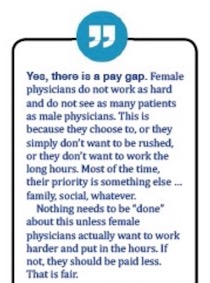
The pay gap between men and women has been a subject of interest recently, particularly in 2018 reports by Doximity and Medscape.
Notably, the gap favors men, is not explained by obvious factors such as hours worked or choice of specialty, and does not seem to be improving. In-depth studies published in the medical literature have examined the relationship between gender and compensation taking into account a wide range of potential confounders, including clinical and academic productivity, leadership roles, age and experience of individual physicians, and place of practice, and found that these factors also do not completely explain the reduced compensation for women in medicine. Further, there is evidence that women may deliver improved care in some contexts, such as caring for women with cardiac disease or decreasing 30 day mortality in certain hospitalized patients.
Yet antiquated perceptions of the value of women in medicine persist. In this month’s Dallas Medical Journal, readers were asked to respond to the question, “Do you believe that a pay gap exists? And if so, what is the cause”? One physician replied, “Yes, there is a pay gap. Female physicians do not work as hard and do not see as many patients as male physicians … Nothing needs to be ‘done’ about this unless female physicians actually want to work harder and put in the hours.” Another said, “I feel the pay gap between female versus male is because of hours worked, specialty and location.” [Note: the issue has been retracted due to the protest against these comments.]
Your patients are rating you online: How to respond. Manage your online reputation: A social media guide. Find out how.



